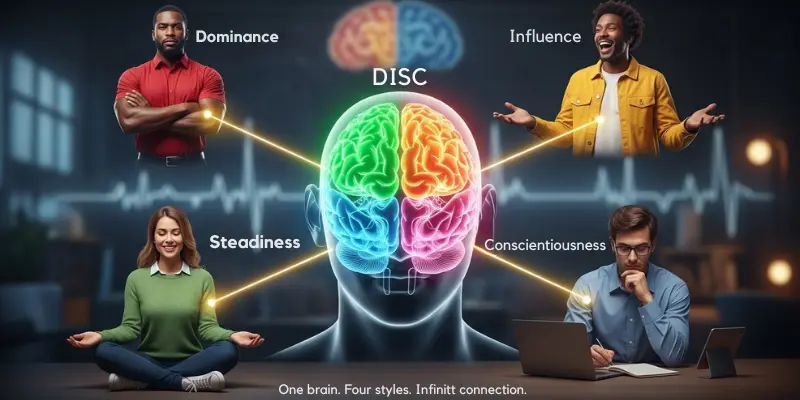What is DISC Theory? A Simple Guide to Understanding Human Behavior
Published: 13 Oct 2025
Welcome, Ambitious Souls!
Do you ever feel confused about why people act differently in the same situation? I felt the same way. Some people talk a lot; some stay quiet. Some like to lead; others want to help. That’s when I found something exciting: What is DISC theory? It’s a simple idea showing four main ways people behave: Dominance, Influence, Steadiness, and Conscientiousness. DISC theory helps us understand ourselves and others better.

My name is Tanveer, and I’ve been learning and writing about people’s behaviour for many years. In this article, I will explain the DISC theory, who made it, what the four types mean, how it helps in real life, and even some facts and problems.
After reading this, you will understand why you act the way you do and why others behave differently. Let’s start this fun and eye-opening journey together!
What is DISC Theory
DISC theory is a simple way to understand “how people behave. “It was created by a psychologist named William Marston in 1928. He believed people act differently based on how they feel and see the world. To simplify it, he grouped behaviour into four main types: Dominance, Influence, Steadiness, and Conscientiousness.
Understanding yourself is the beginning of all wisdom.Aristotle
Each type shows a different style of doing things. For example:
- People with Dominance like to lead and take quick action.
- Those with Influence enjoy talking, sharing ideas, and being social.
- Steadiness types are calm, kind, and like peace.
- Conscientious people focus on details, plans, and doing things correctly.
When I first learned about DISC theory, I finally understood why some friends love leading while others enjoy helping from behind. We all have our own style. Every phone has different settings, but all still work well.
DISC theory helps us understand these styles. It doesn’t say one is better than the other. Instead, it helps us understand ourselves and others so we can get along better, talk clearly, and work as a team.

Origin and History of DISC Theory
To truly understand DISC theory, we must look at where it started and how it has changed. Just like a strong building needs a solid foundation, the early ideas of DISC still support how people use it today in schools, offices, and many other places.
Marston’s Behavior Theory
Marston thought our actions come from how we see ourselves and how much control we have. He didn’t design DISC as a test, but his theory gave the world a new understanding of human behaviour.
I remember reading about Marston and thinking, “This explains why some people take charge while others avoid conflict.” It felt like I was learning the secret code behind how people work.
Who Was William Marston?
William Marston was a psychologist, author, and inventor who believed people show their behaviour in precise and repeatable patterns. In 1928, he wrote a book called Emotions of Normal People, which introduced the idea of four main behaviour styles, the early version of what we now call DISC theory.
The Four DISC Personality Types
DISC theory divides people into four main personality types. Each type shows different ways people think, feel, and act. Understanding these types is like having a map that helps us understand why people behave the way they do.
The more you know yourself, the more clarity there is. Self-knowledge has no end.Jiddu Krishnamurti
Personal insight: I’ve seen how knowing these types made my work and friendships easier; it’s like learning a new language that everyone speaks differently.
- People with the Dominant style are confident and like to get results fast. They enjoy challenges and take charge in tough situations. For example, a team leader who pushes everyone to meet deadlines shows Dominance.
- I remember working with a “D” personality who always focused on fixing problems quickly; it helped the whole group stay on track.
- The Influence type is outgoing and loves charming others with energy and ideas.
- They are friendly and enjoy being around people. Imagine a salesperson who easily makes friends and inspires customers, that’s an “I” personality.
- I’ve found that “I” types bring fun and motivation wherever they go.
- People with steadiness are calm, patient, and very supportive.
- They like peace and helping others feel safe. Think of a good listener who stays calm during arguments, that’s an “S” type.
- When I worked with “S” personalities, their peaceful nature helped settle tensions and build trust.
- The Conscientiousness type pays close attention to details and likes to do things properly.
- They are careful and like to follow the rules. An accountant who checks every number twice demonstrates this style.
- I once worked with a “C” personality whose careful work saved the team from big mistakes.
How DISC Theory Helps in Daily Life
DISC theory is more than an idea; it can make everyday life easier. Understanding the four personality types teaches you to talk better with others, grow yourself, and build stronger connections.
Learning DISC felt like getting a pair of glasses that made people’s actions clearer and less confusing.
1. Better Communication
- Knowing DISC types helps you see why people say or do things differently. This understanding lowers the chances of arguments and fights.
- For example, when I realized a friend was a “Steadiness” type who prefers calm talks, I changed how I spoke to avoid conflicts. DISC helps you communicate in ways others understand, making conversations smoother.
When dealing with people, remember you are not dealing with creatures of logic, but with creatures of emotion.Dale Carnegie
2. Self-Awareness and Growth
- DISC helps you discover your strengths and weaknesses. By knowing your style, you can work on improving yourself and using your natural talents better.
- I’m more of an “Influence” type, which means I love sharing ideas but sometimes make rash decisions. Learning this helped me slow down and think more clearly.
3. Improved Relationships
- Knowing DISC types helps you connect with people better at school, home, or work. It teaches you to respect differences and work as a team.
- I’ve seen how understanding DISC made my friendships stronger because I stopped expecting everyone to act like me. It’s like learning the secret to getting along with people.
Disadvantages of DISC Theory
While DISC theory is helpful in many ways, it’s not perfect. Like any tool, it has limits. It gives a general view of behaviour but doesn’t explain everything. I’ve used DISC many times, and though it’s useful, I’ve also seen where it can fall short.
| 1. Oversimplifies Human Behavior |
|---|
|
| 2. Not Scientifically Perfect |
|---|
|
| 3. Can Lead to Labelling |
|---|
|
Conclusion
So, what is DISC theory? It’s a simple but powerful way to understand different personality styles, such as dominance, influence, steadiness, and conscientiousness. While imperfect, DISC can improve communication, boost self-awareness, and help build better relationships.
In my experience, DISC has helped me become a better listener, teammate, and friend. I recommend using it as a guide, not a label, to improve how you see and treat people around you.
Take the first step now: find your DISC style and explore the power of self-understanding.
Frequently Asked Questions (FAQs)
After learning about what DISC theory is, many people still have questions. Here are some simple answers to help you understand DISC even better.
DISC stands for Dominance, Influence, Steadiness, and Conscientiousness. These are the four main personality styles based on how people behave. Each shows how we respond to challenges, people, pace, and rules.
The DISC theory was created by William Marston, a psychologist and author. He shared the idea in his 1928 book Emotions of Normal People. Marston believed people behave in repeatable patterns based on how they see the world.
Yes, DISC is often used as a personality assessment, but it’s not a test with right or wrong answers. It simply shows your natural behaviour style. It helps people understand themselves and others better.
DISC can improve how you talk, work, and connect with others. It helps reduce misunderstandings and build stronger relationships. Many students, workers, and leaders use it to grow personally and professionally.
Yes, most people have a blend of two or more DISC types. You may be stronger in one area but still show traits from others. That’s what makes everyone unique.
Many schools and companies use DISC to improve teamwork, leadership, and communication. It helps students learn how to work with classmates and helps workers better understand their teams. It’s helpful in both personal and professional life.
DISC is based on psychology, not deep medical science like neuroscience. It’s a helpful tool for understanding behaviour, not a clinical or diagnostic test. Use it as a guide, not a final judgment.
DISC focuses on behaviour patterns, not deep personality traits or emotions. Other tests, like the MBTI or the Big Five, go deeper into psychology. DISC is simple, quick, and easy to use in everyday life.
Your DISC style can change slightly depending on life experiences, job roles, or stress levels. But your natural core style usually stays the same. Self-awareness helps you adjust when needed.
You can take a DISC assessment online from many trusted websites. Some are free, and others offer detailed reports for a small cost. Just ensure it’s a reliable source with accurate results.
| References Sources |
|---|
The Science Behind Everything DiSC. Academic Research on the DISC Model. |

- Be Respectful
- Stay Relevant
- Stay Positive
- True Feedback
- Encourage Discussion
- Avoid Spamming
- No Fake News
- Don't Copy-Paste
- No Personal Attacks

- Be Respectful
- Stay Relevant
- Stay Positive
- True Feedback
- Encourage Discussion
- Avoid Spamming
- No Fake News
- Don't Copy-Paste
- No Personal Attacks





